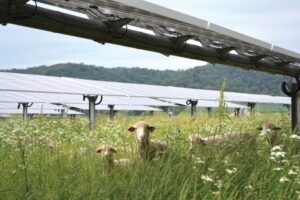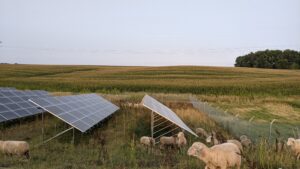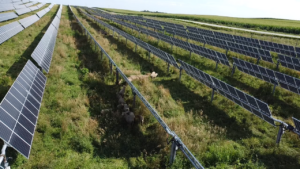Final report for FNC20-1213
Project Information
Cannon Valley Graziers is a diversified sheep operation, including wool and lamb production as well as grazing services. The Cannon Valley Graziers flock has successfully completed targeted grazing projects across Rice and Dakota counties - specializing in ecological disturbance and soil fertility within native, invasive and agricultural systems. Prior to this grant, our operation has utilized intensive rotational grazing practices.
Our project will examine the economic feasibility and environmental benefits of co-locating sheep on photovoltaic utility solar sites in Minnesota. During the 2020 and 2021 seasons, Cannon Valley Graziers will be entering a vegetation management contract on a 25-acre solar site in Dundas, Minnesota. There, we will use rotational grazing practices to provide an alternative to conventional vegetation management. During the time of this grant, we will be working as members of the American Solar Grazing Association to assist in developing best practices for sheep producers and solar developers in the upper Midwest.
Initial grazing plans will be revised throughout the grant based on findings to reflect best practices. Environmental benefits will be measured with scheduled soil samples and infiltration tests, and observational records will be kept. To measure the economic viability of solar grazing in our region, we will demonstrate monthly cash flow records, analyze return on assets (ROI), and evaluate the feasibility of solar grazing as a new/expanded enterprise with actual and projected income statements. Throughout the duration of the grant, we will share our findings and experience with sheep producers, solar developers, soil conservation districts, advocacy organizations, and Minnesota state and local agencies.
Short term (23 months):
- Evaluate the economic and ecological effectiveness of replacing conventional solar site management (mechanical mowers/trimmers) with rotationally grazed sheep in the upper midwest.
- Prototype and improve fence and water systems, stocking rates, and flock management for efficient solar/sheep co-location.
- Develop and improve grazing plan specific to solar grazing in the region including; pasture mix and
- Share results with other farmers/ranchers at field days and
Long term (Beyond grant):
- Develop baseline data and basis for future research collaborations (educational institutions and/or non-profits, government).
- Impact policy for co-location of agriculture and solar energy in Minnesota.
Research
In 2018-2019 we secured a grazing contract for the maintenance of a Nautilus Solar Energy site in Dundas, MN. The 25 acre site was chosen due to its close proximity to our headquarters and nearby access to water on a neighboring vegetable farm.
The site will be planted with two distinct seed mixes: a pollinator friendly perimeter planting, and a sheep friendly array mix of orchardgrass, tall fescue, meadow fescue, perennial ryegrass, kentucky bluegrass, birdsfoot trefoil, white dutch clover, and kura clover–all to be planted during the spring of 2020. A nurse crop will be planted with the perennial mix to ensure competition against weeds. Sheep will be added once groundcover is established in mid summer 2020– groundcover will be monitored in order to not graze too early.
All interior fencing and watering systems are temporary and portable for rotational management. We will use a three-strand electric fencing system, which requires less labor than electronet fence. Solar panels are oriented east-west, and temporary fencing will run parallel to solar panel lengths. Solar panels provide sheep with shade and shelter from inclimate weather. Rambouillet and Katahdin sheep breeds are docile, polled, and do not climb. Our proposed watering system will consist of a portable water tank trailer, with hoses that outflow into 45 gallon stock tanks.
Soil samples and infiltration tests will be taken from four geo-plotted locations three times throughout the grant. Control samples will be taken from adjacent ground that remains in conventional corn and soy production. A grazing plan will be designed, implemented, and revised two times throughout the life of the grant. Cash flow will be monitored monthly, return on investment (ROI) and income statements (actual, projected) will be completed at the end of the grant to evaluate economic benefits. Project findings will be synthesized and shared during outreach events.
As of February 1, 2021, there have been a number of major developments in the progress of our project:
- Our contract with Nautilus Solar was dissolved before we were able to implement our project on site. Until May of 2020, we had primarily been in contact with a site manager who was confident that she would receive approval for our pilot project. However, when we submitted the proposal to the executives, they expressed that solar grazing was not a risk they wanted to take at that time. This development was a major setback, and required us to apply for a grant extension.
- Beginning in May of 2020, we began reaching out to other solar developers that we had previously made contact with. Three MN-based solar companies expressed interest in working with us for the 2021 season, and as a result we engaged in conversations with their teams and developed plans for the pilot projects.
- By January of 2021, we identified a total of 3-5 solar sites that will be suitable for 2021 trials, and each of the three solar developers have approved pricing. In addition, we have secured an insurance policy that meets the contractor requirements for each company, and have written a preliminary grazing schedule.
Next steps will include the implementation of the project itself, but instead of the whole project taking place on one twenty-five-acre site, we will instead operate on 3-5, five-acre sites. All materials and methods will remain the same.
Educational & Outreach Activities
Participation Summary:
Josie Trople presented an overview of Solar Grazing, and shared our project using a power point at the Northern Plains Sustainable Agriculture Society's "Farmer Forum." Approximately 10 in attendance.
Upon the implementation of our project, we will be working with the Minnesota Farmers Union (MFU) to spread information about solar grazing to Farmers throughout Minnesota. We will be scheduling a field day with MFU, and will be writing an article for their monthly newsletter. In addition, we will have access to their press list, and will be sending out photos and a press release to a number of news outlets.
As of January 29, 2022, Arlo Hark gave two presentations, one in conjunction with UMN's Extension Office and the Ecological Livestock Service Network. Presentations included an overview of our operation and of solar grazing, how our farm has benefitted from the practice of solar grazing, and resources for other individuals interested in becoming involved. The second presentation was in conjunction with Clean Energy Resource Team. Presentation included an overview of solar grazing, tailored for solar industry professionals.
As of November 14, 2022, Arlo Hark sat on two panels at a conference hosted by the MN Solar Industry Association. These panels highlighted the benefits of solar grazing and other "agri-voltaic" practices to solar industry professionals. The Land Stewardship project also wrote an article, Solar Power Land Access, for their newsletter highlighting our work, and Josie Trople was featured in their podcast, talking about issues of land access for beginning farmers, and finding creative solutions to overcoming that particular challenge.
Learning Outcomes
As of Jan 29, 2022, We have successfully secured 45 acres of solar grazing contracts for 2022, and are positioned to expand our scope significantly. The income from our solar grazing contracts will allow us to secure financing for the necessary infrastructure to scale up in 2023 and beyond. We continue to build relationships with developers in the region, and have seen greatly expanded interest in the practice of solar grazing. In addition, we have also partnered with native landscape industry professionals, and have begun the process of developing a pollinator-friendly, sheep friendly solar array seed mix to be used on sites where solar grazing is anticipated.
In the next decade, thousands of acres in Minnesota will be used for solar energy production, providing the shepherds of the upper midwest with a pivotal opportunity to diversify their farm income.
One on-the-ground aspect of this project that we still need to address is creating efficient systems for providing water to the sheep while they are on site. We plan to continue iterating a number of concepts, including trailer and stationary water tank setups.
November 14, 2022
As of yesterday, our 2022 grazing season has officially come to a close. During this final year of our study, we were able to effectively implement solar grazing systems on a number of solar sites throughout southern Minnesota. Throughout our grazing season, we learned that with the proper implementation practices sheep can be an effective alternative to mowing, and can save solar developers money on annual maintenance costs. A lesson learned from this project is that while approaching the task of managing vegetation on solar sites, sheep must not be the only tool available for annual maintenance, especially on sites that are early in their ground cover establishment. Usually, some level of mowing or string trimming is necessary to meet the developers management needs, and to provide a high-quality service in general.
Another lesson learned from this project, is that the issue of water on sites is still unresolved. Providing water to the livestock is an extremely labor intensive endeavor, even with a trailer that contains a water tank. Not having an on-site well requires a network of public water stations where the grazier can fill up their tanks, and it also requires an enormous amount of labor, as solar sites are often quite far from the fill up stations. There is significant potential for developers to work with graziers during the design phase of their projects to optimize the efficiency of solar grazing systems.
Finally, after this season of grazing, we have learned that solar grazing can help shepherds diversify their annual income, but it should not be an enterprise that is taken lightly. Managing solar sites requires lots of labor, expensive insurance, and the proper knowledge of how to best use grazing as a vegetation management technique. Solar grazing is not like grazing rented pasture, or other land leases. Graziers provide a valuable service, and because it is a relatively new practice in the Upper Midwest, it is crucial that the early practitioners are good stewards, and work to create positive, long-term benefits for not only themselves, but for their clients, their sites, and for the ecology of land itself.
Project Outcomes
N/A


